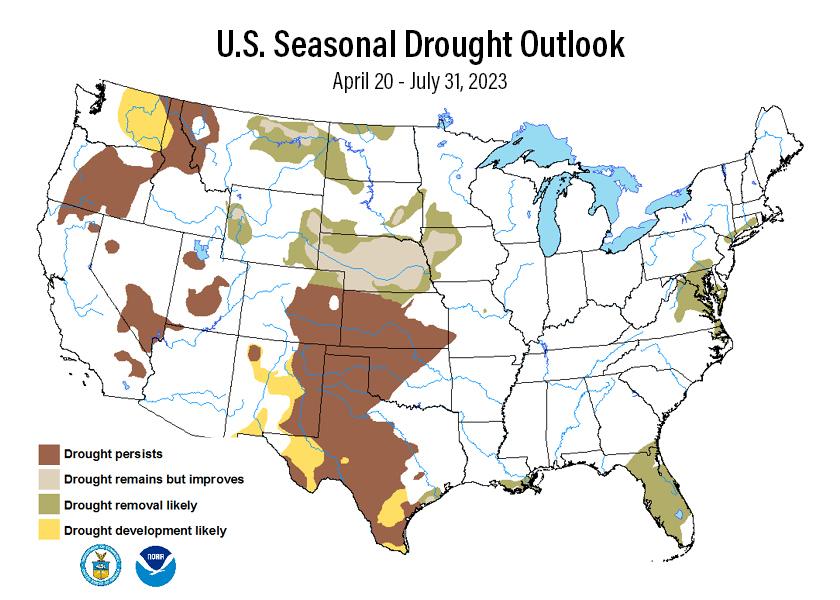Punishing Drought Now Expected to Persist Through July Across Texas, Plains

The updated Seasonal Drought Outlook for the U.S. is painting a grim picture for many drought-plagued areas of the Plains. While the National Weather Service (NWS) forecasts drought to persist from Kansas to Texas, forecasters also expect drought to improve in parts of Nebraska and Iowa and even disappear in some areas.
The NWS Climate Prediction Center points out the drought situation across the country has dramatically improved for many areas. The U.S. Drought Monitor shows drought is currently near its lowest point since July 2020. Drought peaked in October of 2022 at nearly 63% of the country, and since then, it's steadily declined across much of the West, northern Great Plains, Midwest, Tennessee and Ohio Valleys.

Areas of the country seeing relentless drought conditions growing even worse are western Kansas, western Oklahoma and the western half of Texas. This week's Seasonal Drought Outlook indicates those geographies hardest-hit by drought won't see much change through July.
“Persistence is more likely for southeast Colorado and much of Kansas with drought so well entrenched in these areas that improvement will be difficult,” the Seasonal Drought Outlook stated. “The highest confidence for removal exists across the Dakotas, Nebraska, eastern Montana and Wyoming.”
Agricultural meteorologist Eric Snodgrass thinks parts of Kansas, Nebraska and Colorado could see better chances for precipitation as we head into May. He thinks those increased chances of could also fall across Oklahoma and Texas.
“This is going to be something we're going to watch very, very carefully because of the extensive drought in that area,” says Snodgrass, the Principal Atmospheric Scientist with Nutrien Ag Solutions. “So, we have to kind of balance it out. Right. We need the moisture in those areas. We need the moisture in the western Corn Belt, but it is slowing down some of this early season fieldwork.”
Read More: Kansas Winter Wheat Crop Crippled by Drought that Covers 80% of the State
While the chances of rain could improve over the coming weeks, Snodgrass says he’s still aligned with NWS in thinking drought conditions continue to persist in those areas. He says it will take a heavy amount of rain to help those areas climb out of the extreme drought.
“The trouble is some of the drought right now anchored in Kansas and Oklahoma, Colorado and Texas is rivaling the drought of ‘11 and ‘12. It's rivaling the 1950s. It's rivaling the 1930s in terms of how dry it's been since late last summer,” says Snograss. “To undo a drought that intense, and that long lasting, just takes a tremendous amount of effort.”
While drought relief is wanted in those areas, Snodgrass points out too much rain could result In massive flooding.
“There needs to be the slow, methodical increase of precipitation in May and in June, to make us not worry so much about the rest of summer. But right now, I'd have to say that the National Weather Service and the Climate Prediction Center, they have a pretty good handle on what we expect the drought situation look like across the Plains.”
With no moisture in the soil profile, USDA meteorologist Brad Rippey is also watching the development of El Nino. As the U.S. transitions away from La Nina and to El Nino sooner than sone forecasters expected, it could bring more chances of rain.
Read More: Dust Bowl 2.0? How the Drought is Washing Out Hopes of Texas Cotton Production This Year
However, Rippey knows if rains don’t come soon, it’s more than winter wheat conditions that will struggle. He points out as farmers need rain to plant, it also means summer crops are at stake.
“If you talked to me a month ago, I would have been talking about how we expect to see El Nino by the end of the calendar year. But all of a sudden, as we look at the how the Pacific Ocean is evolving, it seems like El Nino is more and more imminent each passing day,” says Rippey. “From a drought standpoint, that ultimately should be good news for these drought affected areas of the Great Plains, because that should help this transition out of drought. But the big question is will it come in time to salvage summer crop planting.”
Pasture and range conditions are also struggling due to the drought parked over key cattle production areas. Rippey says the weekly Crop Progress report from USDA won’t show a national snapshot of pasture conditions until the first week of May. He says when you look at state-by-state reports, it shows for the week ending April 16, 2023, the percent in poor to very poor condition is historically high:
- Oklahoma 58%
- Texas 57%
- Colorado 38%
- Montana 36%
- Wyoming 27%
- New Mexico 20%
“Certainly, the numbers we come, we see coming in from the Central and Southern Great Plains are rivaling some of our worst drought years,” says Rippey. “You have to remember that's a statewide value. Oklahoma is pretty well split between wet conditions in the southeast, and punishing drought in the northwest, there's a line pretty much down I-44 that separates that area. So, there's some really rough pasture and range land conditions across the northwestern half of the state.”
Rippey says when you couple the poor pasture and range conditions with the worst overall U.S. winter wheat conditions since the spring of 1996, it shows grazing and hay could continue to be an issue for cattle producers this year.







